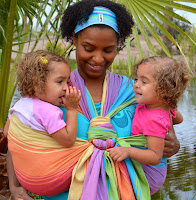 |
| Volunteer Babywearing Educator Lizz Witt wearing her toddler in a standard size Onbu |
The Carry of the Month for July is the Onbuhimo demonstrated by Liz Witt, Volunteer Babywearing Educator for the Babywearing International of Phoenix Chapter.
The Onbuhimo is a traditional Japanese style carrier that has been worn since the Kamakura Period in Japan. Traditionally babies were carried high on the backs of their caregivers in an Obi belt. Later back support was added for the baby and the Onbuhimo came into use. The word Onbuhimo is derived from two Japanese words, Onbuhimo describing the act of carrying a baby on the back, and Himo, meaning long strap or rope. This is a description of the components of the modern day carrier. In Japan and western babywearing the addition of the ring and buckle waist have added ease of use to the carrier for the wearer.
The Onbuhimo is available as a ring waist with wrap style straps from the shoulders, padded shoulders with webbing and buckles, and as a reverse with rings at the shoulders and wrap straps at the waist. Despite the number of options, the Onbuhimo is worn as a front carry or more traditionally as a back carry. The carries are high, at the center of mass of the wearer, using the strength of the back of the wearer and abdominal core muscles to sustain the carry. As with any panel style carrier the baby being worn should be sitting unassisted before attempting any back carries. Liz will be demonstrating wearing a buckle style Onbuhimo.
Completing the Carry
Back Carry with Superman TossBefore you begin loosen both straps on your carrier extending the webbing as far as it can go. If present, adjust your personal fit adjusters (PFAs) to your comfort level.
Adjust your chest clip low to sit across the top of your chest.
Place baby's legs in the loops created by the shoulder straps.
The shoulder straps should be placed under bay's arms or over the shoulders.
In one swift motion lift baby up and over your shoulder to your back.
Buckle your chest clip.
Tighten the webbing on the shoulder straps.
Adjust the seat so that baby is sitting in the center of the carrier.
Completed Carry Back View:
Completed Carry Side view:
Back Carry with Hip Scoot
Loosen the webbing on your shoulder straps and chest clip.
Place your baby's legs into the loops for the shoulder straps.
Tighten your shoulder straps
Check and adjust baby's seat to make sure they are centered.
That's it! You have completed a back carry in an Onbuhimo.
Front Carry in an Onbuhimo
Loosen the shoulder straps and adjust the PFAs as needed.
Adjust your chest clip up high on the shoulders
Place baby's legs in the shoulder straps.
Pick baby up and place high on your chest.
Holding baby with one hand, slide your arms into the shoulder harness.
Trace the shoulder harness up with each hand to the chest clip.

Buckle the chest clip and tighten

Tighten the shoulder straps and adjust baby's seat as needed
Congratulations on a successful Front Carry in an Onbuhimo
Here is a video tutorial, with closed captions, by Advanced Babywearing Educator Lauren Maynard from babywearing International of Phoenix showing front carry in an Onbuhimo with a small baby in a ring waist wrap strap Onbuhimo:
Another tutorial, with closed captions, by Advanced Babywearing Educator Lauren Maynard from babywearing International of Phoenix showing a back carry with a toddler using a superman toss in an Onbuhimo with ring waist and wrap straps:
The prize for the Carry of the Month this July is a wrap scrap keychain with images to follow shortly. To enter to win, simply post a photo of you trying out SSC Hip Carry on the COTM thread in our Facebook group, if you're not on Facebook email your entry to us at PhoenixBabywearers@gmail.com.
(Valid only for Arizona residents. Winner is responsible for pick up or any shipping costs.)
At the end of the month we will draw a winner. To earn additional entries, you can post a new picture of you trying it out every day.
Disclaimer: Any tutorials or advice given on this blog by Babywearing International of Phoenix or representatives of BWI of Phoenix are to be used at your own risk. Please use caution when attempting any of the carries highlighted on this blog and using any of the carriers discussed on this blog. Some of the information or advice may put some users of this site at risk due to health issues, physical limitations, or misuse. If you or your child have health issues or physical limitations, please discuss the appropriateness of the carry or carrier with your health care practitioner. BWI of Phoenix cannot be held accountable for any injuries sustained by the reader when attempting these carries or using these carriers.
Our contributing author this month is LaKeta Kemp. LaKeta is a Volunteer Babywearing Educator in Training with the Babywearing International of Phoenix. She is passionate about safe babywearing and tandem babywearing. Look for LaKeta and her twins at East Valley Meetings.
March 2017 Note: This post has been edited. This carrier style name used to be incorrectly shortened to Onbu. We are using the correct terminology now as recommended by the statement at #NotYourPodBuTai. You can read the statement here and Babywearing International's statement in support of this statement here.





























